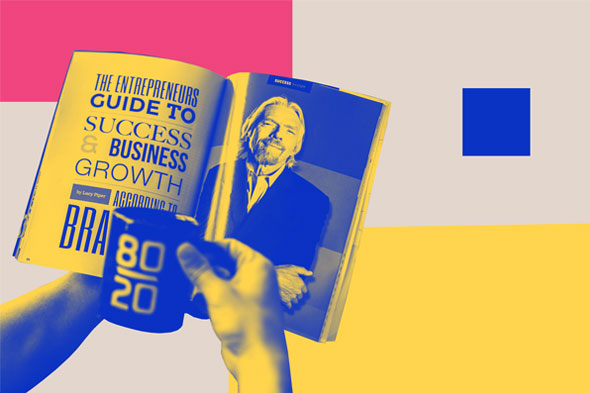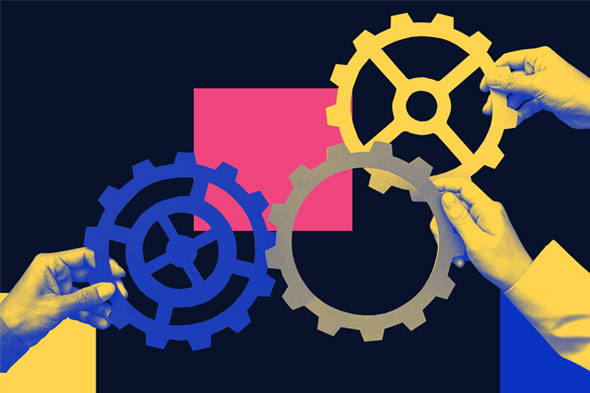

Design Agency Pricing Model Explained
Looking to hire a design agency, but not sure what to budget for? Here’s a complete breakdown of the design agency pricing model.

.svg)
Table of Contents

From a logo and website, to social media and ads - professional design can help your business stand out. But how does design agency pricing work, and is the hefty price tag always worth it? Let’s dig in!
Need professional graphic design? Then a reputable graphic design agencies can be a great choice!
But from branding agencies, to digital marketing and web design - you’ve certainly got a lot of options to choose from. Before we get into the design agency pricing model, let’s first see what kind of services these companies offer.
What does a design age do?
Design agencies don’t have a fixed set of services, so it’s best to check the agency’s scope of work before discussing your pricing options.
Here are a few common projects most agencies can help you with.
Logos and branding
Branding agencies are often full-services agencies that offer the full range of services, from market and competitor research to the execution of your campaigns.
Besides your logo, these companies will also always create brand guidelines, which is an extremely valuable asset whenever you hire external design collaborators.
{{BRAND_PORTFOLIO="/dev/components"}}
Website design
Web design agencies often charge several thousands of dollars, even for a relatively simple website. How come?
You’ll find that each and every element of your website in this case is high-quality and custom made to reflect your target audience and goals. Of course, most web design agencies also take care of development, which boosts the price.
{{WEBSITES_PORTFOLIO="/dev/components"}}
Print and editorial design
Hiring a professional print design agency can be one of the best decisions you can make. Not only do you get stunning print materials that people actually take time with - you can also rest assured that all assets are print-ready, so you can avoid redos and extra printing charges.
Digital marketing
In today’s every-evolving marketing world, it pays to help a professional help you out. Digital marketing agencies offer all kinds of services, from social media to PPC. They often also take care of copywriting, although you should definitely double check that. Since these projects are rarely a one-off occurrence, it’s vital that you find the pricing model that works for you.
Illustrations
Illustration is an area of graphic design that requires a very specific skill set and often software. So, even if you have a designer in-house, there’s a solid chance they won’t have the required skills for complex illustrations.
As it’s such a specific skill set, you’ll find that many illustration agencies actually work as representatives of independent artists.
{{ILLUSTRATIONS_PORTFOLIO="/dev/components"}}
Presentations
You might think that a PowerPoint presentation is something you can easily do yourself. However, as presentations are often meant for investors, professional design can be a truly smart investment.
If you design presentations on a regular basis, just consider how much of the time spent would be better directed at actually doing your job (e.g. marketing strategy, financial planning, etc.).
{{PRESENTATIONS_PORTFOLIO="/dev/components"}}
Product design
When we talk about product design agencies nowadays we usually refer to companies that create and develop digital products. They have teams of experienced UX/UI designers and developers who take products from initial ideas to fully functional digital products.
Although these companies are also website design services (after all a basic website is a digital product too), their expertise is especially important in developing digital apps, and ecommerce sites focused on conversions.
Design agency pricing models: 8 options
Now that you know what kinds of services they offer, let’s discuss a few common pricing models you may wish to consider with their main pros and cons.
1. Hourly rate
Agencies charge by the hour based on the time spent on a project. This model is suited for clients with evolving or undefined project scopes where flexibility is needed.
While it offers flexibility, hourly pricing is often the most expensive, especially if you don’t have a good grasp of the graphic design process. On top of that, it doesn’t really foster a long-term client relationship, and sometimes you might get deliverables later,
Pros:
- Pay only for time worked
- Flexible for ongoing or changing needs
- Transparent breakdown of costs
Cons:
- Hard to predict final cost
- May incentivize slower work
- Less control over total budget
2. Fixed project fee
With a fixed project cost you know exactly what you’re paying for, and how much it will cost in the end.
This is probably the most common web design agency pricing model, as website design usually requires lots of tweaks and revisions, so hourly pricing is usually not viable. However, the limitations of this project is that it can limit your creativity. For example, you might want to add an extra page or animated design element to your site - you’ll need to pay extra for that.
Pros:
- Predictable cost
- Clear scope and deliverables
- Easier budgeting for clients
Cons:
- Limited flexibility for scope changes
- Agencies may add buffer costs for safety
- Risk of miscommunication if specs change
3. Retainer model
This design agency pricing model means that clients pay a recurring monthly fee for ongoing design services. Ideal for businesses that need consistent creative support, like marketing campaigns or social media content.
So, does it mean that if you pay a fixed price you get whatever you need? Not exactly. A retainer usually specifies how many hours designers work, so you will need to figure out if that fits with your budget and needs.
This model is great for big marketing teams that handle a lot of projects on a daily basis. Since you’ll often need to sign some sort of contract, you might end up wasting a lot of money on design work you don’t need, before you can get out of it.
Pros:
- Guaranteed agency availability
- Consistent monthly expense
- Builds long-term collaboration
Cons:
- May pay for unused hours
- Requires long-term commitment
- Can be hard to adjust scope quickly
4. Value-based pricing
This is definitely not the most common design agency pricing model, but it does come with its benefits.
Pricing is based on the perceived value and results the design delivers (e.g., desired profit margins, brand positioning). Suited for clients prioritizing ROI over hourly costs.
The problem with this model is that it’s usually not the best choice for small businesses that are only just starting out. The ROI of a great brand design is huge, but most startups might not be prepared to pay out before they can see the benefits.
It also goes without saying that giving an average cost in this case is virtually impossible. It all depends on your company’s size, project requirements and goals, and, at the end of the day, the capacity of the agency to determine a reasonable value. So, unpredictability is another issue here.
Pros:
- Aligns cost with business outcomes
- Rewards high-impact work
- Encourages strategic, innovative thinking
Cons:
- Hard to quantify value upfront
- May seem expensive to price-sensitive clients
- Requires deep client–agency trust
5. Performance-based pricing
This model is the polar opposite of the previous one in a way. Whereas value-based pricing is focused on long-term goals, performance-based pricing prioritizes short-term goals.
Fees are tied to measurable results, such as conversions or sales. Works well for campaigns with clear KPIs and metrics. It’s a good option for mid to large-scale marketing teams
The downside of this model is that it’s not suitable for every type of design project (e.g. it can be difficult to calculate how a logo design performs). On top of that, this model can sometimes prioritize speed and uniformity over creativity, and limit your space to grow and innovate through design.
Pros:
- Lower risk for clients
- Incentivizes agency to deliver results
- Aligns interests of both parties
Cons:
- Difficult for brand/creative-only projects
- Tracking metrics can be complex
- May undervalue creative work without immediate ROI
6. Commission-based pricing
This model is quite similar to performance-based pricing, except it’s tied to financial outcome.
The agency takes a percentage of sales, revenue, or profits generated by the design work (e.g., a percentage of product sales influenced by packaging design). This model is ideal for clients who want minimal upfront costs and agencies confident in the commercial impact of their work.
It’s quite obvious that this model is not ideal for agencies, as lack of performance could lead to a loss in revenue. For this reason, it’s the least common pricing model, so it may be challenging to find a collaborator that offers this option.
But are there also any downsides for clients?
The main downside is that results can be difficult to attribute accurately. For example, a profit increase may not have been due to an ad campaign that the agency created, but cold calls made by the company’s CEO team. This can be difficult to prove and/or agree with the agency about the terms.
Pros:
- Low or no upfront cost for clients
- Aligns agency earnings with project success
- Motivates agency to maximize performance
Cons:
- Complex to track and attribute results accurately
- Risky for agencies if sales underperform
- Negotiating fair percentages can be challenging
7. Subscription / Unlimited design
It’s probably the least well known design agency pricing model, but arguably the most effective.
In this case clients pay a flat monthly fee for unlimited requests and revisions. Most unlimited design agencies have a vast scope of service, and a pretty fast turnaround (typically 1-2 days).
The prices are typically lower, especially when compared to web design agency pricing models - you’d usually get a website design package for a fraction of the price.
So, what are the downsides? These agencies often have large teams, so the designers’ experience levels can vary. Most importantly, don’t expect the same level of personal connections. If you’re a big fan of Zoom meetings, in most cases this isn’t what you’ll get.
However, you will still work directly with designers - either through Slack, custom design platforms, or other communication channels.
Pros:
- Predictable cost and unlimited requests
- Fast delivery cycles
- Scalable for high-volume design needs
Cons:
- Quality can vary with volume
- Not ideal for large one-off projects
- Limited strategic input (focus on output)
Get the most affordable deal on graphic design!
When choosing a design agency pricing model that works for you, it’s important to understand your design needs: what you need, how often, and how much money you can spend.
Of course, bear in mind that in most cases a traditional design agency will charge several thousand dollars for a single project. Although this often includes additional services, such as copywriting, market research and web development, there is a much simpler, more affordable way to get all your design needs.
ManyPixels is one of the top-rated design subscription services, with over 6 years of experience and thousands of happy clients. We have a relatively small, but highly select team complete with professional project managers who help the design process run smoothly.
Starting at just $599 you can get all your designs under one roof! No need to calculate hourly rates, or constantly change your budget for additional revisions. With flat-rate design you always know what you’re paying.
Unlike traditional agencies, you’re also not bound by any contracts - you’re free to pause or cancel your subscription at any time.
So what are you waiting for? Get started today, or get in touch with us for 1:1 consultation on your business’ design needs.
Having lived and studied in London and Berlin, I'm back in native Serbia, working remotely and writing short stories and plays in my free time. With previous experience in the nonprofit sector, I'm currently writing about the universal language of good graphic design. I make mix CDs and my playlists are almost exclusively 1960s.
A design solution you will love
Fast & Reliable
Fixed Monthly Rate
Flexible & Scalable
Pro Designers






